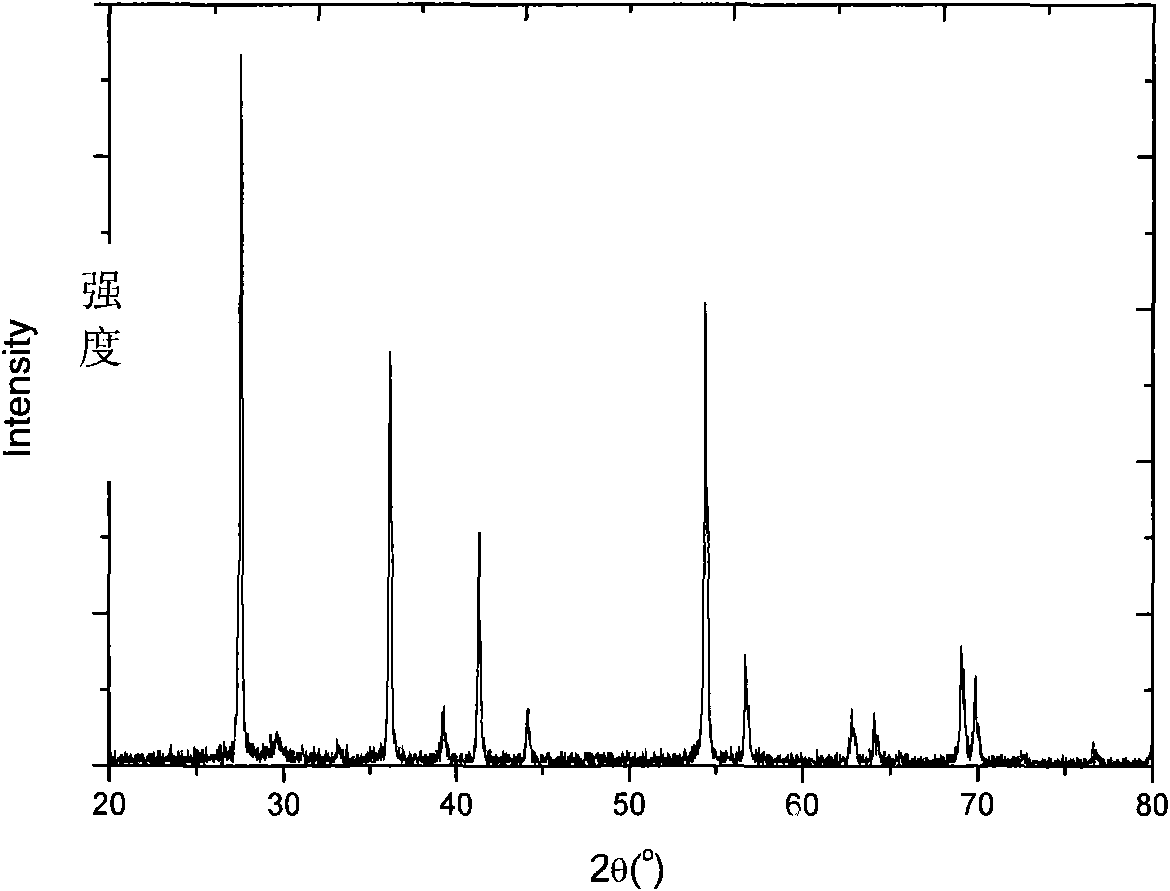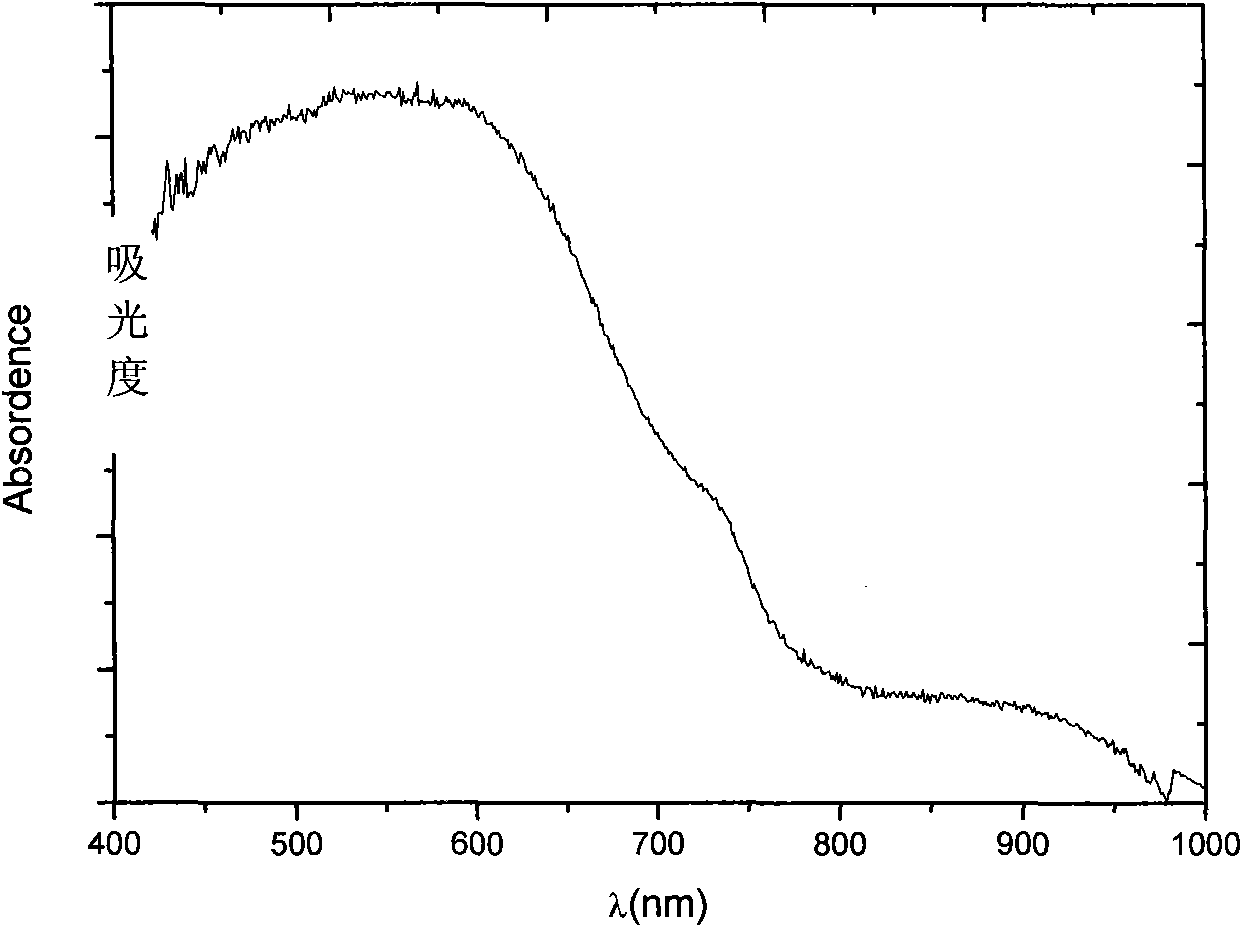Molybdenum-containing semi-conductor photocatalysis material responding to visible light, preparation method and application thereof
A photocatalytic material and visible light technology, applied in the direction of catalyst activation/preparation, semiconductor devices, chemical instruments and methods, etc., can solve the problems of reducing photon quantum efficiency, low sunlight efficiency, and inability to absorb visible light, etc., and achieve a wide range of synthesis conditions, The effect of abundant storage, improved utilization level and high added value
- Summary
- Abstract
- Description
- Claims
- Application Information
AI Technical Summary
Problems solved by technology
Method used
Image
Examples
Embodiment 1
[0026] A method for preparing a molybdenum-containing semiconductor photocatalytic material responsive to visible light, comprising the steps of:
[0027] 1) Selection of raw materials:
[0028] Synthesis of M by high temperature and high pressure solid state reaction 2 m 1 FeMoO 6 , (M 1 Take the K element as an example; M 2 Take the Sr element as an example)
[0029] Raw materials used (analytically pure) K 2 CO 3 1.38g,
[0030] (purity above 99.5%) MoO 3 2.88g,
[0031] Analytical pure SrCO 3 2.95g,
[0032] Analytical pure Fe 2 o 3 1.60g,
[0033] Its chemical reaction equation:
[0034]K 2 CO 3 +2MoO 3 +2SrCO 3 +2Fe 2 o 3 →2SrKFeMoO 6 +3CO 2 ↑
[0035] K 2 CO 3 Slightly excessive.
[0036] 2) After weighing the above-mentioned raw materials according to the above-mentioned doses, put them into a mortar, mix them and carefully grind them into micron-level powders, then put them into a φ10mm×20mm platinum crucible, and heat up to...
Embodiment 2
[0038] A method for preparing a molybdenum-containing semiconductor photocatalytic material responsive to visible light, comprising the steps of:
[0039] 1) Selection of raw materials:
[0040] Synthesis of M by high-temperature solid-state reaction 2 m 1 FeMoO 6 (M 1 Take Na element as an example; M 2 Take Ba element as an example)
[0041] Raw materials used (analytical pure) Na 2 CO 3 1.06g,
[0042] (purity above 99.5%) MoO 3 2.88g,
[0043] Analytical pure BaCO 3 3.95g,
[0044] Analytical pure Fe 2 o 3 1.60g,
[0045] Its chemical reaction equation:
[0046] Na 2 CO 3 +2MoO 3 +2BaCO 3 +Fe 2 o 3 →2BaNaFeMoO 6 +3CO 2 ↑
[0047] 2) After weighing the above-mentioned raw materials according to the above-mentioned doses, put them into a mortar, mix them and carefully grind them into micron-level powders, then put them into a φ10mm×20mm platinum crucible, and heat up to 50°C / min in a muffle furnace. Pre-fire at 500°C for 12 hours, take...
Embodiment 3
[0049] A method for preparing a molybdenum-containing semiconductor photocatalytic material responsive to visible light, comprising the steps of:
[0050] 1) Selection of raw materials:
[0051] Synthesis of SrKFeMoO by High Temperature Solid State Reaction 6 (M 1 Take the K element as an example; M 2 Take the Sr element as an example)
[0052] Raw materials used (analytically pure) K 2 SO 4 1.74g,
[0053] (purity above 99.5%) MoO 3 2.88g,
[0054] Analytical pure SrCl 2 3.18g,
[0055] Analytical grade FeCl 3 ·6H 2 O 5.41g,
[0056] Its chemical reaction equation:
[0057] K 2 SO 4 +2MoO 3 +2SrCl 2 +2FeCl 3 ·6H 2 O→2SrKFeMoO 6 +SO 3 ↑+H 2 O↑+10HCl↑,
[0058] FeCl 3 ·6H 2 O slightly excessive.
[0059] 2) After weighing the above-mentioned raw materials according to the above-mentioned doses, put them into a mortar, mix them and carefully grind them, then put them into a φ10mm×20mm platinum crucible, heat up to 500°C at a ra...
PUM
 Login to View More
Login to View More Abstract
Description
Claims
Application Information
 Login to View More
Login to View More - R&D
- Intellectual Property
- Life Sciences
- Materials
- Tech Scout
- Unparalleled Data Quality
- Higher Quality Content
- 60% Fewer Hallucinations
Browse by: Latest US Patents, China's latest patents, Technical Efficacy Thesaurus, Application Domain, Technology Topic, Popular Technical Reports.
© 2025 PatSnap. All rights reserved.Legal|Privacy policy|Modern Slavery Act Transparency Statement|Sitemap|About US| Contact US: help@patsnap.com


